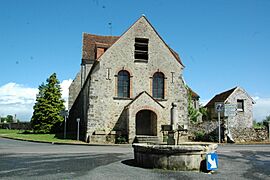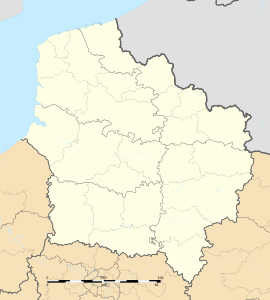Artonges facts for kids
Quick facts for kids
Artonges
|
|
|---|---|
|
Part of Dhuys-et-Morin-en-Brie
|
|
 |
|
| Country | France |
| Region | Hauts-de-France |
| Department | Aisne |
| Arrondissement | Château-Thierry |
| Canton | Essômes-sur-Marne |
| Commune | Dhuys-et-Morin-en-Brie |
| Area
1
|
13.12 km2 (5.07 sq mi) |
| Population
(2021)
|
172 |
| • Density | 13.11/km2 (33.95/sq mi) |
| Time zone | UTC+01:00 (CET) |
| • Summer (DST) | UTC+02:00 (CEST) |
| Postal code |
02330
|
| Elevation | 140–211 m (459–692 ft) (avg. 165 m or 541 ft) |
| 1 French Land Register data, which excludes lakes, ponds, glaciers > 1 km2 (0.386 sq mi or 247 acres) and river estuaries. | |
Artonges is a small former town in the Aisne area of northern France. It used to be its own commune (like a small local government area). But on January 1, 2016, Artonges joined with other towns to form a new, bigger commune called Dhuys-et-Morin-en-Brie.
Contents
Exploring Artonges: Geography and Location
Artonges is located in the southern part of the Aisne region. It sits on a high flat area, not far from where the Dhuys river begins. It's also close to the edge of a forest called "Rouges Fossés," which means "Red Ditches."
This area is about 20 kilometers (12 miles) southeast of Château-Thierry. It's also about 35 kilometers (22 miles) southwest of Épernay, a famous city. You can reach Artonges by road D20, which goes through the village. There's also a railway line with a station called Artongeole just north of the village. The land around Artonges is a mix of farms and forests.
A small stream called the Ru des Rieux flows through the village. It starts to the west and then flows southwest into a larger valley called the Ravine de la Dhuys.
Nearby Towns and Villages
 |
Viffort | Pargny-la-Dhuys | Verdon |  |
| Fontenelle-en-Brie | Corrobert | |||
| Marchais-en-Brie | Montmirail | Vauchamps |
A Glimpse into Artonges' History
The name Hertungiae was first written down in the year 1137. This shows that Artonges has a long history, going back many centuries.
How Artonges Was Run: Administration
Before it merged, Artonges had its own local government. The town was led by a mayor. Here are some of the people who served as mayor:
| From | To | Name |
|---|---|---|
| 2001 | 2008 | François Girard |
| 2008 | 2016 | Gislaine Dadou |
Who Lives in Artonges: Demography
The people who live in Artonges are called Artongeois (for boys and men) or Artongeoises (for girls and women) in French.
The number of people living in Artonges has changed over many years. Here's how the population has grown and shrunk:
| Historical population | |||||||||||||||||||||||||||||||||||||||||||||||||||||||||||||||||||||||||||||||||||||||||||||||||||||||||||||||||||
|---|---|---|---|---|---|---|---|---|---|---|---|---|---|---|---|---|---|---|---|---|---|---|---|---|---|---|---|---|---|---|---|---|---|---|---|---|---|---|---|---|---|---|---|---|---|---|---|---|---|---|---|---|---|---|---|---|---|---|---|---|---|---|---|---|---|---|---|---|---|---|---|---|---|---|---|---|---|---|---|---|---|---|---|---|---|---|---|---|---|---|---|---|---|---|---|---|---|---|---|---|---|---|---|---|---|---|---|---|---|---|---|---|---|---|---|
|
|
||||||||||||||||||||||||||||||||||||||||||||||||||||||||||||||||||||||||||||||||||||||||||||||||||||||||||||||||||
| Source: EHESS and INSEE | |||||||||||||||||||||||||||||||||||||||||||||||||||||||||||||||||||||||||||||||||||||||||||||||||||||||||||||||||||
Important Places and Buildings
Artonges has several interesting historical sites:
- The Church of Saint Peter is a very old building. The oldest parts, like the choir (where the altar is) and the Transept (the arms of the cross-shaped church), were built in the 15th century. It has been rebuilt and repaired many times since then. This church doesn't have a tall bell tower. Instead, its bell is in a small window-like structure called a Dormer on the side of the roof. The church was fully restored and reopened in 2009. Inside, there's a beautiful Stained glass window from the 16th century that shows Christ on the Cross. This window is considered a historical object.
- The Fountain in Artonges is special because it has a constant supply of water. People once believed this water could help cure sore throats and fevers!
- The Lavoir is a public laundry building. In the past, people used to wash their clothes here. This particular lavoir is decorated with pictures from a famous fable by Jean de La Fontaine called "The fox, the flies, and the hedgehog."
- The Chateau is an old castle or manor house. It used to be a very important place, connected to the lords of Montmirail. Today, it is privately owned.
See also
 In Spanish: Artonges para niños
In Spanish: Artonges para niños



